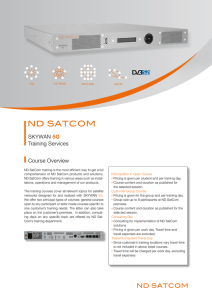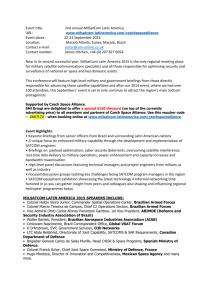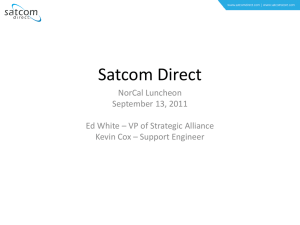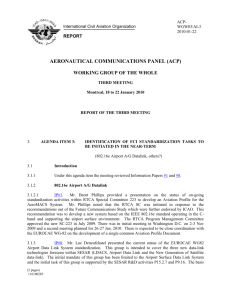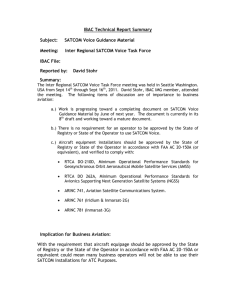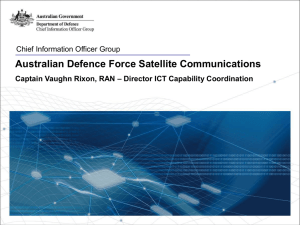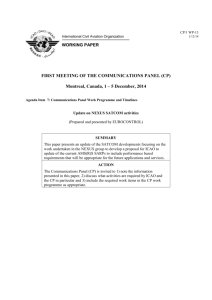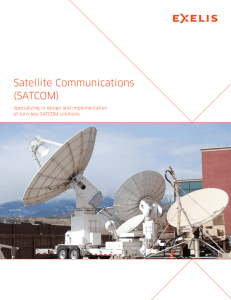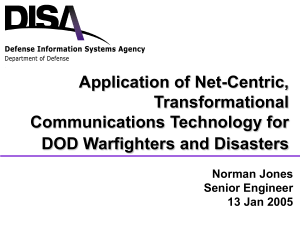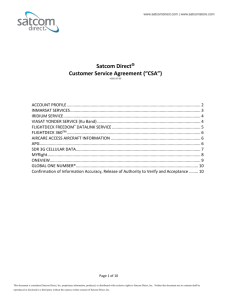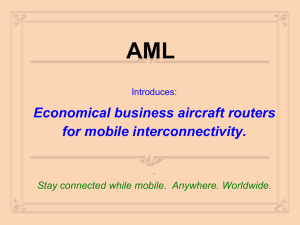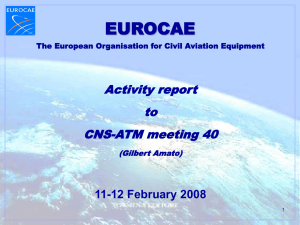WG-82_IP on WG-82 SATCOM_CP1_IP3
advertisement
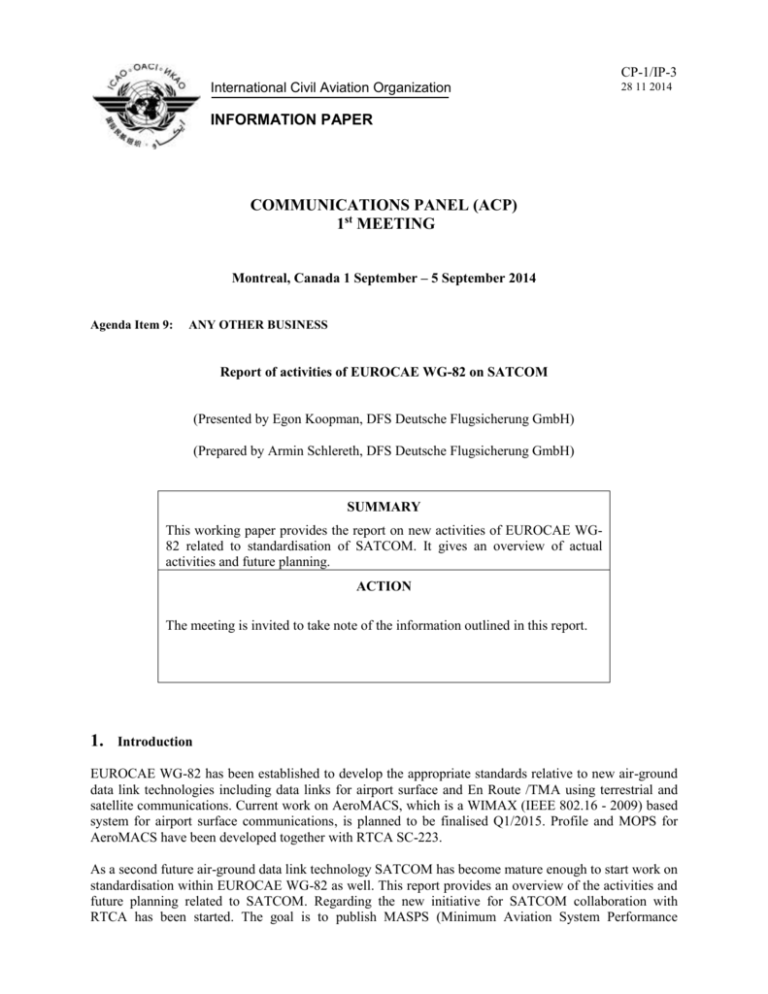
CP-1/IP-3 International Civil Aviation Organization 28 11 2014 INFORMATION PAPER COMMUNICATIONS PANEL (ACP) 1st MEETING Montreal, Canada 1 September – 5 September 2014 Agenda Item 9: ANY OTHER BUSINESS Report of activities of EUROCAE WG-82 on SATCOM (Presented by Egon Koopman, DFS Deutsche Flugsicherung GmbH) (Prepared by Armin Schlereth, DFS Deutsche Flugsicherung GmbH) SUMMARY This working paper provides the report on new activities of EUROCAE WG82 related to standardisation of SATCOM. It gives an overview of actual activities and future planning. ACTION The meeting is invited to take note of the information outlined in this report. 1. Introduction EUROCAE WG-82 has been established to develop the appropriate standards relative to new air-ground data link technologies including data links for airport surface and En Route /TMA using terrestrial and satellite communications. Current work on AeroMACS, which is a WIMAX (IEEE 802.16 - 2009) based system for airport surface communications, is planned to be finalised Q1/2015. Profile and MOPS for AeroMACS have been developed together with RTCA SC-223. As a second future air-ground data link technology SATCOM has become mature enough to start work on standardisation within EUROCAE WG-82 as well. This report provides an overview of the activities and future planning related to SATCOM. Regarding the new initiative for SATCOM collaboration with RTCA has been started. The goal is to publish MASPS (Minimum Aviation System Performance ACP-WGS01/WP-xx -2- Standards) and MOPS (Minimum Operational Performance Standards) for SATCOM Class A and Class B together with RTCA SC-222. Further on coordination with other relevant working groups of EUROCAE (e.g. WG-78) and Special Committees of RTCA (e.g. SC214 and SC206) are envisaged. 2. TOR of WG-82 The following text is an extract of the TOR of EUROCAE WG-82 and provides an overview of the standards to be developed and the time planning for delivery of these documents: Working Group Objectives: Satcom datalink Standardization of Class A and Class B SATCOM performance levels. It has already been identified in ICAO ACP that the current SATCOM (AMS(R)S) include relaxed delay requirements (20 and 30 seconds) which are not compatible with the performance requirements of the services required to support the SESAR and NextGEN concepts. Therefore it is needed to update the current SATCOM SARPs to include more stringent performance requirements. For this purpose, EUROCONTROL has established the NEXUS group to facilitate the development of a consensus proposal to ICAO for an update of the current AMS(R)S SARPS, while maintaining the compliance of the existing SATCOM systems. Therefore, NEXUS has agreed to structure the proposal to ICAO identifying 3 classes of performance requirements (Class A, B and C) for SATCOM systems as follows: 1) Class C will cover the performance requirements included in the current SARPs and will be applicable to systems already standardized in ICAO (such as INMARSAT Classic Aero/I3, MTSAT and Iridium). Class C is effectively covering oceanic operations. 2) Class B will cover more stringent (compared to Class C) performance requirements (such as the ones required by i4D) and will be applicable to existing but not currently standardised in ICAO SATCOM systems (such as INMARSAT SBB/I4 and Iridium Next) and which are expected to be considered for standardisation in ICAO. Class B will cover oceanic and continental operations. 3) Class A will cover more stringent (compared to Class B) performance requirements (such as the one required by full 4D and the SESAR and NextGEN future concepts) and will be applicable to future SATCOM systems (not available today). Class A will cover oceanic and continental operations. The Class A performance requirements are important as they will serve as design drivers and guidelines for the development of the future SATCOM systems. In addition, it is desired to develop a global (ICAO) standard for a SATCOM system supporting the Class A requirements and allowing different service providers using the same set of avionics to avoid interoperability/interference issues and stimulate equipage. For Class A air ground data link standard will be derived from the Technical Specification issued by the ESA Iris Programme and developed in the Iris ANTARES project. Intended performance requirements can be found in: Mission Requirements Document from SESAR P15.2.6 Definition of QoS capabilities from SESAR P15.2.4 ICAO Communication operating Concept Requirements (COCR) -3- ACP-WGS01/WP-xx For Class B air ground data link standard development will extend RTCA SC-222 material considering the EUROCAE ED-228 and ED-229 to cover continental airspace performance requirements with support from SESAR P15.2.5 and ESA IRIS Precursor (INMARSAT SBB evolution). The following RTCA SC-222 material is available and will be updated accordingly: RTCA DO-262B: SATCOM MOPS (Class C) RTCA DO-343: SATCOM MASPS (Class C) The working group should provide a set of documents; some of them being used to provide basic inputs for ICAO SARPS development and the others to be used as recognised means of compliance. The following documents should be provided: SatCom Class B expected delivery by 2016 ED-XXX System level MASPS ED-YYY Airborne equipment MOPS Documents will be further developed to cover also SATCOM Class A. SatCom Class A expected delivery by 2017 ED-XXX version A System level MASPS ED-YYY version A Airborne equipment MOPS 3. Meetings EUROCAE WG-82 SATCOM subgroup had two meetings up to now. Meeting Kick-off #2 #3 4. Date 8.07.2014 18.11. – 19.11.2014 14.04. – 15.04.2014 Status Held Held Planned Location Paris (France) Brussels (Belgium) Langen (Germany) Remark Potential combined meeting with RTCA SC-222 Status of Work Currently the way how to develop the MASPS and MOPS documents is being defined. The idea would be to use already published RTCA documentation (DO-343, DO262B) for Class C and expand it accordingly. Further coordination with RTCA in that context is required. Inmarsat volunteered to lead development of MASPS and Honeywell volunteered to lead the development of MOPS for SATCOM Class B and Class A. 5. ACTION BY THE MEETING The meeting is invited to take note of the information of this information paper.
